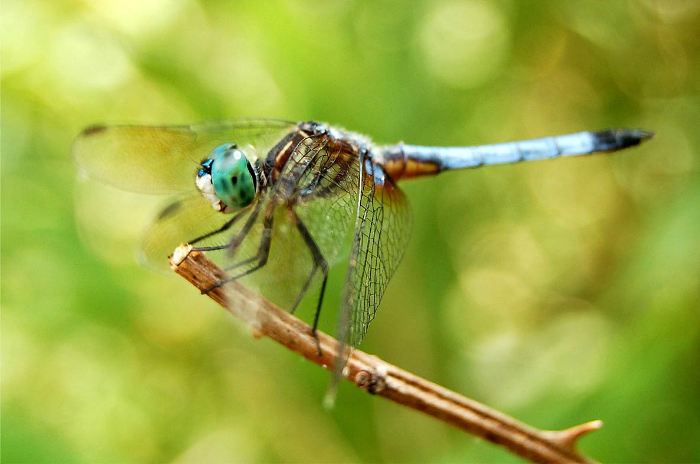File:Dragonfly3.jpg
Dragonfly3.jpg (700 × 464 pixels, file size: 36 KB, MIME type: image/jpeg)
Pretty and Deadly, the Dragonfly
http://www.nytimes.com/2013/04/02/science/dragonflies-natures-deadly-drone-but-prettier.html
http://nyti.ms/1bkobm5 (video)
http://nyti.ms/1bkp3Hj (video)
African lions roar and strut and act the apex carnivore, but they’re lucky to catch 25 percent of the prey they pursue. Great white sharks have 300 slashing teeth and that ominous soundtrack, and still nearly half their hunts fail.
Dragonflies, by contrast, look dainty, glittery and fun, like a bubble bath or costume jewelry, and they’re often grouped with butterflies and ladybugs on the very short list of Insects People Like. Yet they are also voracious aerial predators, and new research suggests they may well be the most brutally effective hunters in the animal kingdom.
When setting off to feed on other flying insects, dragonflies manage to snatch their targets in midair more than 95 percent of the time, often wolfishly consuming the fresh meat on the spur without bothering to alight. “They’ll tear up the prey and mash it into a glob, munch, munch, munch,” said Michael L. May, an emeritus professor of entomology at Rutgers. “It almost looks like a wad of snuff in the mouth before they swallow it.”
Next step: grab more food. Dragonflies may be bantam, but their appetite is bottomless. Stacey Combes, who studies the biomechanics of dragonfly flight at Harvard, once watched a laboratory dragonfly eat 30 flies in a row. “It would have happily kept eating,” she said, “if there had been more food available.”
In a string of recent papers, scientists have pinpointed key features of the dragonfly’s brain, eyes and wings that allow it to hunt so unerringly.
One research team has determined that the nervous system of a dragonfly displays an almost human capacity for selective attention, able to focus on a single prey as it flies amid a cloud of similarly fluttering insects, just as a guest at a party can attend to a friend’s words while ignoring the background chatter.
Other researchers have identified a kind of master circuit of 16 neurons that connect the dragonfly’s brain to its flight motor center in the thorax. With the aid of that neuronal package, a dragonfly can track a moving target, calculate a trajectory to intercept that target and subtly adjust its path as needed.
The scientists found evidence that a dragonfly plots its course to intercept through a variant of “an old mariner’s trick,” said Robert M. Olberg of Union College, who reported the research with his colleagues in Proceedings of the National Academy of Sciences. If you’re heading north on a boat and you see another boat moving, say, 30 degrees to your right, and if as the two of you barrel forward the other boat remains at that 30-degree spot in your field of view, vector mechanics dictate that your boats will crash: better slow down, speed up or turn aside.
In a similar manner, as a dragonfly closes in on a meal, it maintains an image of the moving prey on the same spot, the same compass point of its visual field. “The image of the prey is getting bigger, but if it’s always on the same spot of the retina, the dragonfly will intercept its target,” said Paloma T. Gonzalez-Bellido, an author of the new report who now works at the Marine Biological Laboratory in Woods Hole, Mass.
As a rule, the hunted remains clueless until it’s all over. “Before I got into this work, I’d assumed it was an active chase, like a lion going after an impala,” Dr. Combes said. “But it’s more like ambush predation. The dragonfly comes from behind and below, and the prey doesn’t know what’s coming.”
Dragonflies are magnificent aerialists, able to hover, dive, fly backward and upside down, pivot 360 degrees with three tiny wing beats, and reach speeds of 30 miles per hour, lightning for an arthropod. In many insects, the wings are simple extensions of the thoracic box and are moved largely as a unit, by flexing the entire thorax. In the dragonfly, the four transparent, ultraflexible wings are attached to the thorax by separate muscles and can each be maneuvered independently, lending the insect an extraordinary range of flight options.
“A dragonfly can be missing an entire wing and still capture prey,” Dr. Combes said.
Dragonflies are true visionaries. Their eyes are the largest and possibly the keenest in the insect world, a pair of giant spheres each built of some 30,000 pixel-like facets that together take up pretty much the entire head.
“They have a full field of vision,” Dr. Olberg said. “They can see you when they’re flying toward you and still see you when they’re flying away...”
File history
Click on a date/time to view the file as it appeared at that time.
| Date/Time | Thumbnail | Dimensions | User | Comment | |
|---|---|---|---|---|---|
| current | 01:12, 6 July 2016 |  | 700 × 464 (36 KB) | Siterunner (talk | contribs) |
You cannot overwrite this file.
File usage
The following page uses this file:
